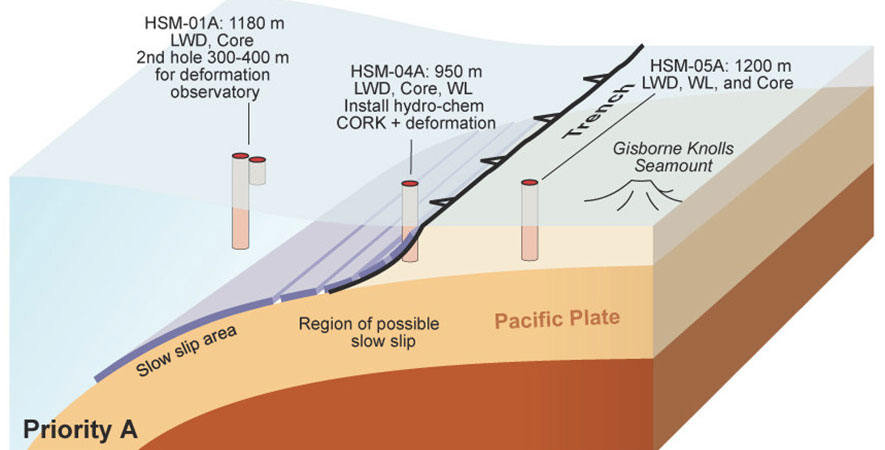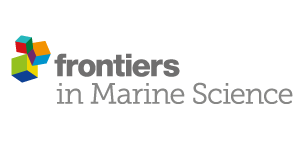The International Ocean Discovery Program (IODP) is now accepting applications for scientific participants on two IODP expeditions aboard the JOIDES Resolution. To learn more about the scientific objectives of these expeditions, life at sea, and how to apply to sail, register for an informational webinar (see links below).
Expedition 372: Creeping Gas Hydrate Slides and Hikurangi Slow Slip LWD
26 November 2017 to 4 January 2018
Expedition 372 has two primary objectives. These are (1) to investigate the relationship between gas hydrate and underwater landslides (IODP proposals 841-APL2 & 841-Add); and (2) to characterize sediment and fault zone structures and physical properties associated with recurring shallow slow slip events along the Hikurangi subduction interface (IODP proposals 781A-Full & 781A-Add). Submarine slides are thought to occur as catastrophic events, and as such pose a significant geohazard potentially causing tsunamis and damaging seafloor installations. Dissociation of gas hydrate has been proposed as a driver of seafloor destabilization, but there is evidence that gas hydrate itself may lead to seafloor weakening through creeping seafloor deformation. We will test the hypothesis that interstitial gas hydrate, like ice, may exhibit viscous behavior leading to slow deformation as observed in terrestrial rock glaciers. Alternatively, permeability reduction from gas hydrates may lead to overpressure, hydrofracturing, and seafloor weakening. To elucidate how gas hydrates promote creeping behavior, we will collect logging-while-drilling (LWD) data at three sites as well as APC cores, pressurized cores, and penetrometer data at one of the LWD sites.
As described for Expedition 375 below, shallow slow slip events (SSE) along the Hikurangi margin provide the opportunity to investigate the physical processes and in situ conditions that govern the spectrum of fault slip modes through a combination of LWD, coring, and continuous monitoring. On Expedition 372, we will acquire LWD data at a series of sites that will be cored and instrumented during the subsequent IODP Hikurangi Subduction Margin Expedition 375 (see below).
Application deadline: 1 October 2016, 11:59 PM EDT
Informational Webinar: 16 September 2016, 3:00-4:00 PM EDT. Click here to register.
Expedition 375: Hikurangi Subduction Margin
8 March to 5 May 2018
Expedition 375 will investigate slow slip events (SSE) along the northern Hikurangi subduction margin (IODP proposals 781A-Full and 781A-Add). Hikurangi SSE recur every ~2 years so we can monitor changes in deformation rate and associated chemical and physical properties surrounding the SSE source area throughout an entire slow slip cycle. Sampling material from the sedimentary section and oceanic basement of the subducting plate and from primary active thrusts in the outer accretionary wedge, in combination with LWD data, will reveal the rock properties, composition, and lithological and structural character of the active faults involved in the SSE, as well as material that is transported downdip to the SSE source region. Coring and downhole measurements from four sites will be integrated with the LWD data collected during Expedition 372 (see above). In addition, borehole observatories will be installed at the thrust fault site and a site in the upper plate to monitor hydrologic, chemical, and physical processes during the SSE cycle.
Application deadline: 1 October 2016, 11:59 PM EDT
Informational Webinar: 20 September 2016, 2:00-3:00 PM EDT. Click here to register.
Opportunities exist for researchers (including graduate students) in all specialties – including but not limited to sedimentologists, structural geologists, paleontologists, biostratigraphers, petrologists, paleomagnetists, petrophysicists, borehole geophysicists, microbiologists, and inorganic/organic geochemists.
U.S.-affiliated scientists interested in participating in these expeditions should apply to sail through the U.S. Science Support Program. The deadline to apply is October 1, 2016.
For questions, please email This email address is being protected from spambots. You need JavaScript enabled to view it..





